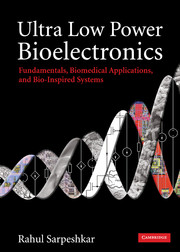Book contents
- Frontmatter
- Contents
- Acknowledgements
- Section I Foundations
- Section II Low-power analog and biomedical circuits
- Section III Low-power RF and energy-harvesting circuits for biomedical systems
- Section IV Biomedical electronic systems
- Section V Principles for ultra-low-power analog and digital design
- Section VI Bio-inspired systems
- 23 Neuromorphic electronics
- 24 Cytomorphic electronics: cell-inspired electronics for systems and synthetic biology
- Section VII Energy sources
- Bibliography
- Index
- Epilogue
- References
24 - Cytomorphic electronics: cell-inspired electronics for systems and synthetic biology
from Section VI - Bio-inspired systems
Published online by Cambridge University Press: 02 December 2010
- Frontmatter
- Contents
- Acknowledgements
- Section I Foundations
- Section II Low-power analog and biomedical circuits
- Section III Low-power RF and energy-harvesting circuits for biomedical systems
- Section IV Biomedical electronic systems
- Section V Principles for ultra-low-power analog and digital design
- Section VI Bio-inspired systems
- 23 Neuromorphic electronics
- 24 Cytomorphic electronics: cell-inspired electronics for systems and synthetic biology
- Section VII Energy sources
- Bibliography
- Index
- Epilogue
- References
Summary
Any living cell carries with it the experience of a billion years of experimentation by its ancestors.
Max DelbrückThe cells in the human body provide examples of phenomenally energy-efficient sensing, actuation, and processing. An average ∼10 μm-size human cell hydrolyzes several energy-carrying adenosine-tri-phosphate (ATP) molecules within it to perform nearly ~107 ATP-dependent biochemical operations per second. Since, under the conditions in the body, the hydrolysis of each ATP molecule provides about 20 kT (8 ×10−20 J) of metabolic energy, the net power consumption of a single human cell is an astoundingly low 0.8 pW! The ~100 trillion cells of the human body thus have an average resting power consumption of ~80 W, consistent with numbers derived from the Appendix of Chapter 23.
The cell processes its mechanical and chemical input signals with highly noisy and imprecise parts. Nevertheless, it performs complex, highly sensitive, and collectively precise hybrid analog-digital signal processing on its inputs such that reliable outputs are produced. Such signal processing enables the cell to sense and amplify minute changes in the concentrations of specific molecules amidst a background of confoundingly similar molecules, to harvest and metabolize energy contained in molecules in its environment, to detoxify and/or transport poisonous molecules out of it, to sense if it has been infected by a virus, to communicate with other cells in its neighborhood, to move, to maintain its structure, to regulate its growth in response to signals in its surround, to speed up chemical reactions via sophisticated enzymes, and to replicate itself when it is appropriate to do so.
Information
- Type
- Chapter
- Information
- Ultra Low Power BioelectronicsFundamentals, Biomedical Applications, and Bio-Inspired Systems, pp. 753 - 786Publisher: Cambridge University PressPrint publication year: 2010
References
Accessibility standard: Unknown
Why this information is here
This section outlines the accessibility features of this content - including support for screen readers, full keyboard navigation and high-contrast display options. This may not be relevant for you.Accessibility Information
- 4
- Cited by
